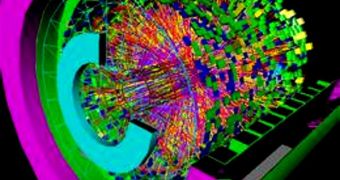The Long Island, New York-based Relativistic Heavy Ion Collider (RHIC) is undoubtedly one of the most advanced particle accelerators in the world. It produces enormously-significant science, and its reputation now stands to gain from a new breakthrough achieved recently. Physicists working with the device managed to produce heavy isotopes of antihydrogen, the antimatter particle of hydrogen. These elementary particles also included the rare antistrange quark, which is significantly heavier than up of down quarks, a more common variety. Because of this extra mass, the isotope was measured to be the heaviest ever produced, exceeding the previous record-holder, antihelium, Nature News reports.
During the investigations, the RHIC experts collided massive amounts of gold nuclei head on, in the 2.4-mile-long tunnels of their accelerator. They only managed to obtain a few antihydrogen, but the number they did detect were enough for studies. The reason why particle physicists are so interested in antinuclei is because these particles could provide them with groundbreaking new data on the phenomena going on inside the cores of neutron stars, or on how the Universe may have looked like immediately after the Big Bang. Neutron stars are the collapsed cores of massive stars, which emit vast amounts of neutrons, and have strong magnetic fields.
Antimatter is the exact opposite to normal matter. It is among the few science-fiction fantasies that are actually rooted in scientific reality. These particles have the exact same mass as their counterparts forming regular matter, but an opposite charge. When the two collide, they immediately annihilate each other, producing a flash of energy in the process. Investigating these interactions is tremendously important, because some theories say that, if the Big Bang indeed occured, then we shouldn't be alive. These scientists argue that equal amounts of matter and antimatter were produced during the event, and so they should have canceled each other out. But this didn't happen, and experts want to learn why.
Out of 100 million gold nuclei collisions, the team only managed to detect 70 antihydrogen atoms. The chances of this type of atoms forming are extremely remote, as a lot of conditions need to be met beforehand. Identifying the particles they were looking for in the haystacks of data would have been impossible for the RHIC team, had they not used a complicated software to peer through the data. The algorithm was created by Shanghai Institute of Applied Physics expert Jinhui Chen, in collaboration with colleague Zhangbu Xu, who is based at the US Department of Energy's (DOE) Brookhaven National Laboratory (BNL). The RHIC is also based at the BNL.

 14 DAY TRIAL //
14 DAY TRIAL //